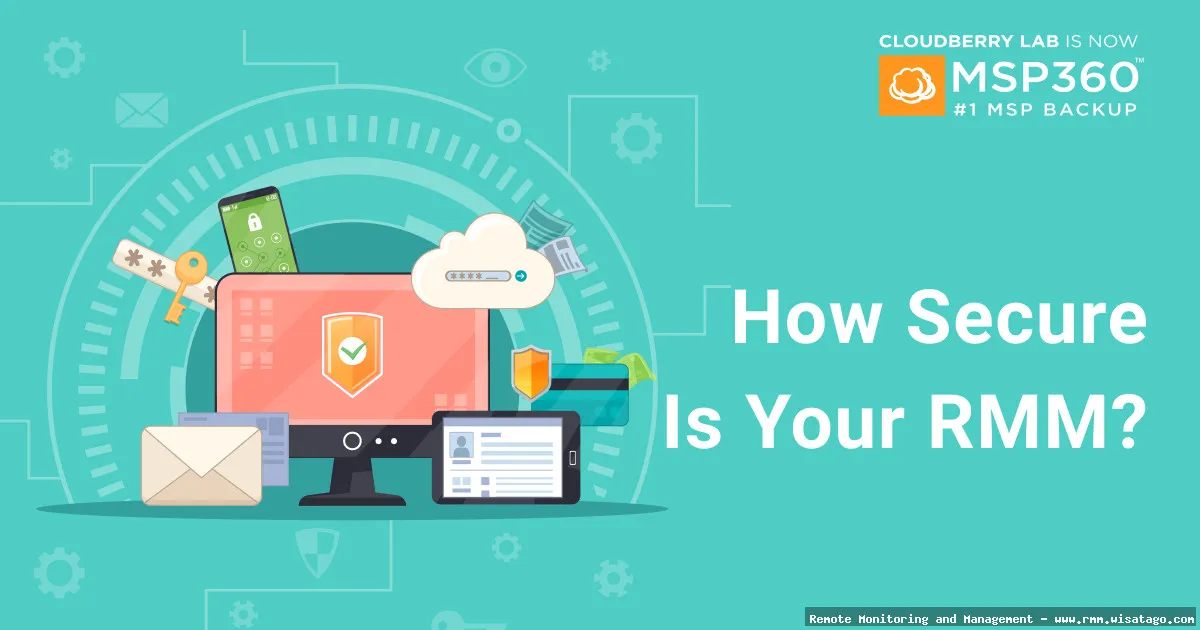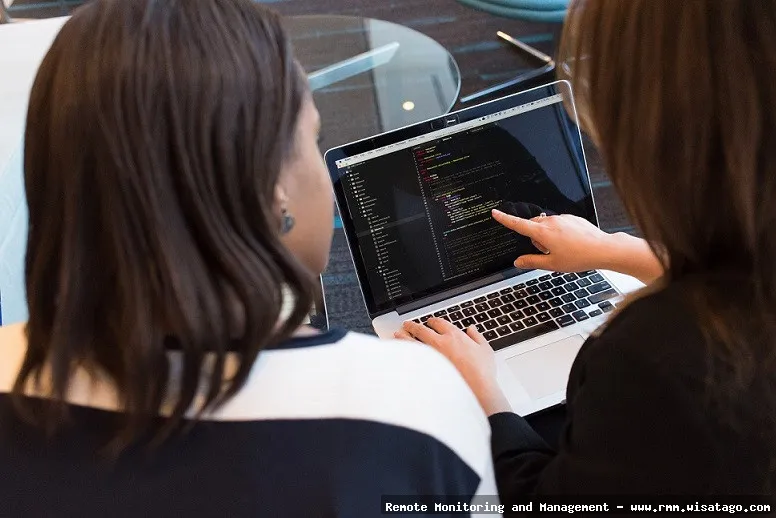In today’s interconnected world, managing IT infrastructure is no longer confined to the four walls of an office. Remote Monitoring and Management (RMM) solutions have become indispensable tools for IT professionals, enabling them to oversee and maintain systems from anywhere in the world. However, this convenience comes with a significant responsibility: ensuring the security of RMM platforms themselves. A compromised RMM system can grant attackers access to a vast network of endpoints, making it a prime target for malicious actors. Therefore, understanding and implementing robust enterprise-grade RMM security protocols is paramount for protecting sensitive data and maintaining business continuity.
Think of RMM as the central nervous system of your IT environment. It’s the platform that allows you to remotely diagnose issues, deploy patches, manage software, and even remotely control devices. Now, imagine if that central nervous system were compromised. An attacker could gain complete control over your entire IT infrastructure, leading to devastating consequences such as data breaches, ransomware attacks, and complete system outages. This is why security can’t be an afterthought; it needs to be baked into the very foundation of your RMM strategy.

This article will delve into the critical aspects of enterprise-grade RMM security protocols, exploring the features, details, and best practices that IT professionals need to know. We’ll cover everything from access control and authentication to encryption and vulnerability management, providing a comprehensive guide to securing your RMM deployment and safeguarding your organization’s digital assets. Let’s explore how to fortify your RMM solution and protect your IT infrastructure from evolving cyber threats.
Understanding the RMM Security Landscape
The RMM landscape is constantly evolving, with new threats and vulnerabilities emerging regularly. To effectively secure your RMM platform, it’s crucial to understand the common attack vectors and security challenges that IT teams face. The value of RMM platforms, offering centralized control, makes them a prime target for sophisticated cyberattacks.
Common RMM Attack Vectors
Attackers often target RMM platforms through various methods, including:
- Credential Stuffing and Brute-Force Attacks: Trying to guess or obtain valid usernames and passwords to gain unauthorized access.
- Phishing Attacks: Tricking users into revealing their credentials or installing malware through deceptive emails or websites.
- Software Vulnerabilities: Exploiting weaknesses in the RMM software itself or its underlying components.
- Supply Chain Attacks: Compromising third-party vendors or suppliers who have access to the RMM platform.
- Insider Threats: Malicious or negligent actions by employees or contractors with authorized access.
Key Security Challenges
Securing an RMM platform presents several challenges, including:
- Complexity: RMM solutions often have complex configurations and dependencies, making it difficult to identify and address all potential vulnerabilities.
- Scalability: As the number of managed devices grows, it becomes increasingly challenging to maintain consistent security across the entire environment.
- Vendor Security Practices: The security of the RMM platform ultimately relies on the vendor’s security practices, which may vary significantly.
- User Awareness: End-user behavior can significantly impact RMM security, making user awareness training crucial.
- Patch Management: Ensuring timely patching of both the RMM platform and the managed devices is critical to mitigating vulnerabilities.
Essential Security Protocols for Enterprise-Grade RMM
Implementing robust security protocols is essential for mitigating the risks associated with RMM platforms. These protocols should cover various aspects, including access control, authentication, encryption, and vulnerability management.
Strong Authentication and Access Control
Controlling access to the RMM platform is paramount. Implement the following measures:

- Multi-Factor Authentication (MFA): Require users to provide multiple forms of identification, such as a password and a one-time code, to access the RMM platform. This significantly reduces the risk of unauthorized access, even if a password is compromised.
- Role-Based Access Control (RBAC): Grant users only the minimum necessary privileges to perform their tasks. This limits the potential damage that a compromised account can cause.
- Regular Password Audits: Enforce strong password policies and regularly audit user accounts to identify and address weak or compromised passwords. Consider using password managers to help users create and manage strong passwords.
- Account Lockout Policies: Implement account lockout policies to prevent brute-force attacks.
Encryption and Data Protection
Protecting sensitive data both in transit and at rest is crucial. Consider these encryption strategies:
- End-to-End Encryption: Ensure that all communication between the RMM platform and the managed devices is encrypted using strong encryption algorithms. This protects data from eavesdropping and tampering.
- Data Encryption at Rest: Encrypt sensitive data stored on the RMM server and the managed devices. This protects data in case of a breach or theft.
- Secure Data Transmission Protocols: Use secure protocols such as HTTPS and SSH for all communication.
Vulnerability Management and Patching
Proactively identifying and addressing vulnerabilities is critical to preventing attacks. Implement the following measures:
- Regular Vulnerability Scanning: Regularly scan the RMM platform and the managed devices for known vulnerabilities.
- Timely Patching: Apply security patches and updates promptly to address identified vulnerabilities. Automate the patching process whenever possible to ensure timely updates.
- Third-Party Software Management: Ensure that all third-party software components used by the RMM platform are up-to-date and secure.
- Penetration Testing: Conduct regular penetration testing to identify and exploit vulnerabilities in the RMM platform.
Endpoint Security Best Practices
The security of the endpoints managed by the RMM platform is just as important as the security of the RMM platform itself. Implement the following endpoint security best practices:
- Antivirus and Anti-Malware Software: Install and maintain up-to-date antivirus and anti-malware software on all managed devices.
- Endpoint Detection and Response (EDR): Implement EDR solutions to detect and respond to advanced threats on the endpoints.
- Firewall Protection: Enable and configure firewalls on all managed devices to block unauthorized access.
- Application Whitelisting: Restrict the execution of applications to only those that are explicitly approved.
- Device Encryption: Encrypt the hard drives of all managed devices to protect data in case of theft or loss.
Logging and Monitoring
Comprehensive logging and monitoring are essential for detecting and responding to security incidents. Implement the following measures:. For more information, you can refer to RMM as an additional resource.
- Centralized Logging: Collect and centralize logs from the RMM platform and the managed devices.
- Security Information and Event Management (SIEM): Use a SIEM system to analyze logs and identify suspicious activity.
- Real-Time Monitoring: Monitor the RMM platform and the managed devices in real-time for security events.
- Alerting and Notifications: Configure alerts and notifications to notify security personnel of suspicious activity.
Vendor Security Assessment and Management
The security of your RMM platform is heavily reliant on the security practices of your RMM vendor. Therefore, it’s crucial to carefully assess and manage the security risks associated with your vendor.
Due Diligence and Vendor Selection
Before selecting an RMM vendor, conduct thorough due diligence to assess their security posture. Consider the following factors:

- Security Certifications: Look for vendors with industry-recognized security certifications, such as ISO 27001 or SOC 2.
- Security Audits: Ask the vendor for the results of their security audits and penetration tests.
- Security Policies and Procedures: Review the vendor’s security policies and procedures to ensure that they align with your organization’s security requirements.
- Data Privacy Practices: Evaluate the vendor’s data privacy practices to ensure that they comply with relevant regulations, such as GDPR.
- Incident Response Plan: Review the vendor’s incident response plan to understand how they will respond to security incidents.
Ongoing Vendor Management
After selecting an RMM vendor, it’s important to continuously monitor their security posture and manage the associated risks. Consider the following measures:
- Regular Security Reviews: Conduct regular security reviews of the vendor’s systems and processes.
- Contractual Agreements: Include security requirements in your contractual agreements with the vendor.
- Incident Reporting: Establish a clear process for reporting security incidents to the vendor.
- Vendor Risk Assessments: Conduct regular vendor risk assessments to identify and mitigate potential security risks.
User Training and Awareness
Even with the most robust security protocols in place, human error can still lead to security breaches. Therefore, user training and awareness are essential components of any RMM security strategy.
Security Awareness Training
Provide regular security awareness training to all users of the RMM platform. The training should cover topics such as:
- Phishing Awareness: Teach users how to identify and avoid phishing attacks.
- Password Security: Educate users on the importance of strong passwords and password management.
- Social Engineering: Explain how social engineering attacks work and how to avoid falling victim to them.
- Data Security: Educate users on the importance of protecting sensitive data.
- Reporting Security Incidents: Teach users how to report security incidents.
Phishing Simulations
Conduct regular phishing simulations to test users’ awareness and identify areas for improvement. Use the results of the simulations to tailor the training to address specific vulnerabilities.
Conclusion
Securing your RMM platform is a critical undertaking that requires a comprehensive and proactive approach. By implementing the security protocols and best practices outlined in this article, you can significantly reduce the risk of a security breach and protect your organization’s sensitive data. Remember that security is an ongoing process, not a one-time event. Continuously monitor your RMM platform for vulnerabilities, update your security protocols, and train your users to stay ahead of evolving cyber threats. By prioritizing RMM security, you can ensure the reliability and integrity of your IT infrastructure and maintain business continuity.
Conclusion
In conclusion, securing enterprise-grade RMM platforms is not merely a best practice, but a fundamental imperative for modern IT management. As we’ve explored, the vulnerabilities inherent in these systems, if left unaddressed, can serve as a gateway for devastating cyberattacks, impacting not only the MSP but also their entire client base. Robust security protocols, encompassing multi-factor authentication, rigorous access control, continuous monitoring, and proactive vulnerability management, are essential to mitigate these risks effectively. Ignoring these measures leaves organizations exposed to significant financial losses, reputational damage, and operational disruption.
The journey towards establishing a secure RMM environment is an ongoing process, demanding constant vigilance and adaptation to the evolving threat landscape. By prioritizing the implementation of the discussed security measures and fostering a culture of security awareness, organizations can significantly strengthen their defenses and build trust with their clients. We urge you to review your current RMM security posture and proactively implement the necessary enhancements. For further guidance and resources on achieving optimal RMM security, consider exploring the best practices outlined by leading cybersecurity organizations and consulting with experienced security professionals. Take action today to protect your business and your clients from the ever-present threat of cyberattacks. Consider reading more on the topic via this comprehensive guide.
Frequently Asked Questions (FAQ) about Enterprise-Grade RMM Security Protocols
What are the most important security protocols I should look for when choosing an enterprise-grade Remote Monitoring and Management (RMM) solution for my business?
When selecting an enterprise-grade RMM solution, security should be your top priority. Look for RMMs that offer multi-factor authentication (MFA) to protect against unauthorized access, even if passwords are compromised. Role-based access control (RBAC) is also crucial, ensuring that technicians only have the permissions needed for their specific tasks, limiting the blast radius of potential breaches. Robust encryption, both in transit and at rest, is essential for protecting sensitive data. Furthermore, the RMM should have strong patch management capabilities to quickly address vulnerabilities in managed endpoints. Finally, ensure the vendor has a documented and tested incident response plan in place.
How can I ensure my existing Remote Monitoring and Management (RMM) solution is adequately protected against ransomware attacks and other advanced persistent threats (APTs)?
Protecting your RMM from ransomware and APTs requires a multi-layered approach. First, regularly review and update your RMM’s security settings, including access controls and authentication policies. Implement endpoint detection and response (EDR) solutions on managed devices to detect and block malicious activity. Enable application control to restrict the execution of unauthorized software. Regularly perform vulnerability scans of your RMM infrastructure and endpoints to identify and remediate weaknesses. Ensure you have robust backup and disaster recovery plans in place to quickly restore systems in the event of a successful attack. Educate your IT staff about phishing and other social engineering tactics used by attackers.
What are the key compliance considerations related to security when using a Remote Monitoring and Management (RMM) platform, especially regarding data privacy regulations like GDPR and HIPAA?
When using an RMM, compliance with data privacy regulations like GDPR and HIPAA is paramount. Understand where your RMM vendor stores data and ensure they comply with the relevant regulations. You need a Data Processing Agreement (DPA) in place with your RMM provider that outlines their responsibilities for protecting personal data. Implement data loss prevention (DLP) measures to prevent sensitive data from leaving your control. Ensure the RMM supports data encryption and access controls to protect data at rest and in transit. Conduct regular security audits of your RMM environment to identify and address compliance gaps. Finally, understand the RMM’s data retention policies and ensure they align with your own data retention requirements under GDPR or HIPAA.